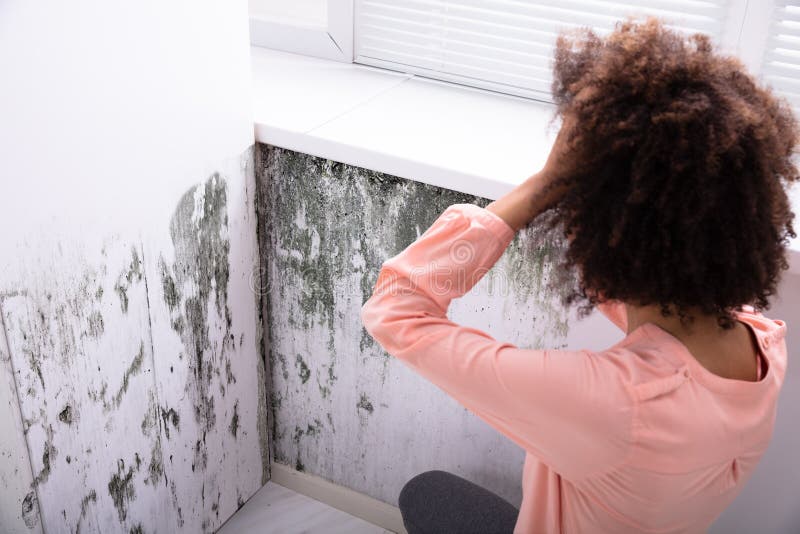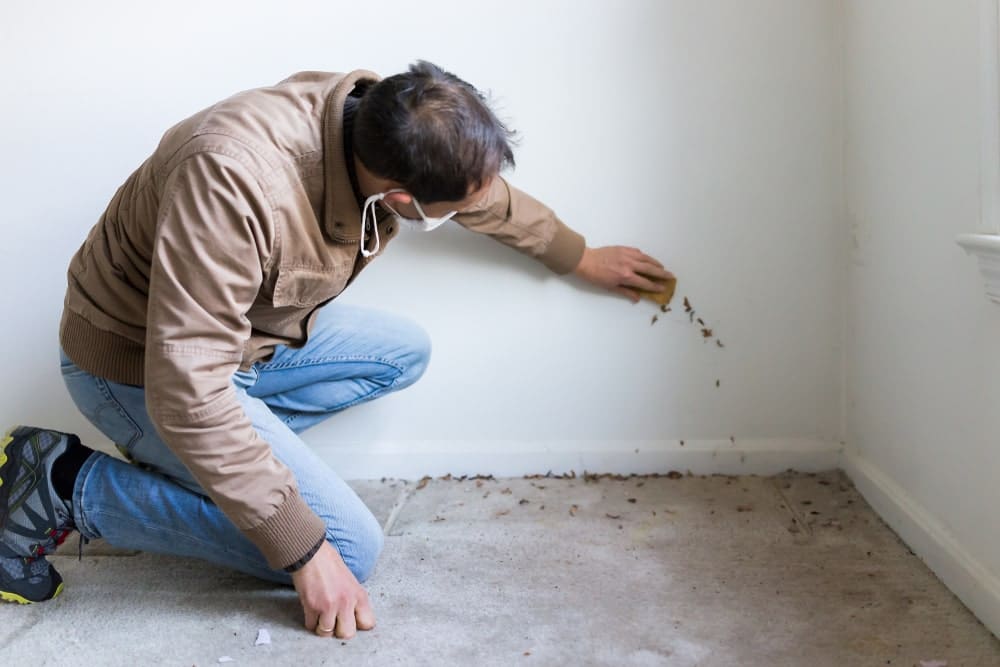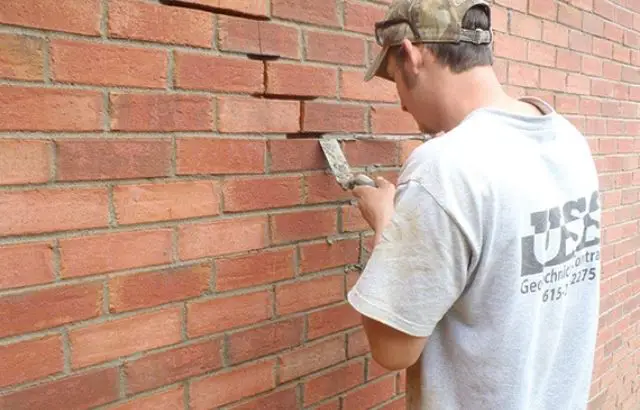Mold on the walls of your home is an extremely annoying and potentially dangerous problem. This calls for action as soon as you notice it. Not only does it smell musty and ugly, but it can also cause health problems and damage your home. In this guide, you will learn how to get rid of mold on walls permanently.
What are the things to wear before cleaning the mold?
Medium-sized (10-100 square feet) and large-sized (over 100 square feet) projects require protective clothing and covering up to prevent exposure to mold spores and contaminated small particles. In general, disposable paper coveralls are acceptable for small-scale projects where only minimal protection is required.
- Protective eyewear, such as goggles.
- At least as effective as an N-95 respirator, if not more so. (On the packaging, search for “N-95” on a coat or other long-sleeved garment.
- Gloves are made for defense.
- Long slacks.
- Boots.
To eradicate mold growth, you must first eliminate the problem or water source sustaining it.
How to Get Rid of Mold on Walls Permanently

If Mold only covers a small area on the walls, it is usually easy to remove. Various household items can be used. Borax, vinegar, baking soda, tea tree oil, bleach, and hydrogen peroxide are helpful cures. However, if you have strong and widespread Mold on your walls, it is not easy to do this.
Removing it yourself is even potentially dangerous. We recommend that you consult a professional mold remover to safely and effectively remove Mold from your home.
Removing Mold on walls essentially involves two important steps. First, you have to regulate the humidity in the house, and then you have to kill the Mold. Ideally, humidity should be between 30 and 60 percent. Here are some ways to get rid of mold from walls.
- Identify the cause of mold
- Prepare the room and clean the walls.
- Remove the Mold.
- Use Borax
- Use Vinegar and baking powder
- Use Tea tree oil
- Use Grapefruit seed extract
- Use Bleach
- Using hydrogen peroxide vinegar
- Give an expert opinion
Identify the cause of the Mold
This is the first and most important step in removing Mold from your walls. Next, you need to determine the cause and fix the problem so that the Mold does not return.

Read More: How To Remove Wall Tiles Without Damaging Plasterboard
This means removing all sources of water damage (e.g. leaks) that have caused Mold and controlling the humidity in your home.
Prepare the room and clean the walls.
/washing-interior-walls-4-7f0658d4e2124a1a9f29507e115318ab.jpg)
When you are ready to remove Mold from the walls, clean the area. Be sure to remove all furniture, fabrics, and electrical appliances from the affected area. Then cover the bottom with plastic sheeting for protection.
Then use a damp sponge with dish soap and scrub the affected area to remove any dirt.
It is recommended to wear protective clothing before cleaning or treating the wall with any product. Safety glasses, rubber gloves, and a face mask protect you from Mold. You should also keep windows and doors open while removing Mold.
Learn More: How To Remove Sand Texture From Walls
Remove the Mold.

If you notice small mold spots on the painted interior walls, it is most likely on the surface. It should be relatively easy to remove with household products. Options include borax, white wine vinegar, baking soda, or tea tree oil.
Do mold stains only cover a limited area of a non-porous (painted or sealed) wall? Then we recommend trying a natural mold remover first. But what if you have a large area of mold development to deal with? Or are natural mold removers not getting enough molds? In this case, you can use a stronger chemical cleaner.
On porous walls made of cement, concrete, or stone, Mold does not only grow on the surface. It also tends to spread inward. So, if you have a mold problem on a porous (unsealed) wall, a combination of hydrogen peroxide and distilled white wine vinegar is the most effective solution.
Use Borax

In a container, mix a cup of borax with a gallon of hot water. Close the lid and shake well to dissolve the borax. Fill a spray bottle with the solution and splash it on the affected area. Use a brush to scrub the Mold off the wall, then wipe it off and let it dry. There is no need to rinse the solution. Borax helps prevent Mold from building up once you’ve removed the source.
Use Vinegar and baking powder

Vinegar is a safe and highly effective means of killing and preventing Mold on all types of walls, both porous and non-porous. White vinegar has been shown to kill 82 percent of mold spores in studies. In addition, it is reported to penetrate porous materials and kill fungi at the root level.
- Fill a spray container with white distilled vinegar without diluting it. Spray vinegar on the wall and let it sit for an hour. Then wipe the area with a clean sponge and warm water.
- After cleaning the wall with vinegar, you may need to clean up the Mold. Again, we recommend preparing a soda solution for this.
- Mold can be destroyed with baking soda, which is a natural disinfectant. It also deodorizes and helps remove the musty, damp odor caused by Mold. Eventually, it absorbs moisture, which effectively protects against Mold.
- To make a baking soda solution, mix a teaspoon of baking soda and two cups of water in a spray bottle and shake well. Then, spray the solution on the affected area and remove the fungus with a washcloth or brush.
- Then rinse the area with warm water to remove any mold residue from the surface. Finally, spray the vinegar or baking soda solution on the wall again to ensure all molds have been removed.

Use Tea tree oil

Tea tree essential oil has antifungal and antibacterial properties, making it a very effective antifungal treatment. This should be between 40% and 60%. Start by adding a teaspoon of tea tree oil and two cups of water to a spray bottle. Next, spray the solution on the affected area and wipe off the Mold with a clean cloth.
There is no need to rinse, as leaving tea tree oil on the surface kills the fungus and prevents it from reproducing. This method is recommended for removing mildew from painted and wallpapered walls.
Use Grapefruit seed extract

The grapefruit seed extract is another very effective natural fungicide. The citric acid in grapefruit naturally kills mold. It also acts as a disinfectant and deodorant.
Make a solution in a spray bottle at the rate of 10 drops of grapefruit seed extract in a glass of water. Shake the bottle to mix well and spray on the affected area. After a few minutes, wipe off the Mold and wipe dry with a clean cloth. The contact of the grapefruit seed extract with the Mold will kill it and prevent the Mold from growing back. You can repeat this process every two or three days to keep it from growing back.
Use Bleach

Bleach effectively kills Mold and mildew on non-porous walls. On porous surfaces, it does not penetrate or kill the roots. But before you start cleaning, try using bleach on an inconspicuous part of the wall. This will ensure that it does not damage the finish.
You need to mix one part bleach with three parts water and then apply the solution to the wall. Leave on for 10 minutes, and then rub the shape with a brush. Rinse well and dry gently with a clean cloth.
Using hydrogen peroxide vinegar

Hydrogen peroxide has antifungal, antiviral, and antibacterial properties – great for killing fungi (Trusted). When hydrogen peroxide and distilled white vinegar are combined, the solution becomes more durable and safer to use in removing Mold, as it does not produce poisonous gases or leave toxic residues as bleach does.
Studies have shown that white vinegar kills 82 percent of mold spores. In addition, its effervescent properties make it more effective than bleach in removing Mold from porous surfaces. On porous and non-porous walls, hydrogen peroxide can be used.
According to ServiceMaster Restoration and Cleaning, the mild acid in vinegar kills about 82% of known molds and can help prevent future outbreaks.
Pour a 3 percent concentration of hydrogen peroxide, undiluted, into a spray bottle and spray the affected area. Let sit on the surface for 10-15 minutes, and then scrub the walls with a brush to remove any mildew.
Give an expert opinion.
If you suspect mold in your bathroom, you can use a mold test kit to confirm the presence of mold. If the tests confirm the presence of mold, you should use the above measures to remove it from the walls and any other affected areas. Act immediately if you know what to do and notice mold stains on your walls.
- Manage humidity levels in moist areas, such as bathrooms, to prevent mold growth. If your mold issue gets unmanageable, mold removal services are always available.
- As indicated by the fuzzy structures protruding from the shower’s corner, mold creates tendrils when its spores land and germinate on a surface. If water is present, mold can grow on any surface, including ceiling tiles, wood, paint, rubber, carpet, soil, and dust.
- The recommended bleach solution ratio for killing mold is one bleach to ten parts water. Bleach is a caustic chemical that can cause respiratory issues if inhaled; therefore, it works in a well-ventilated area. Utilize a spray bottle, a sponge, and a bucket to apply the solution to the mold. Except for areas used for food preparation, there is no need to rinse the surface after application.
- Vinegar is significantly more effective than bleach and other toxic chemicals for mold removal. Vinegar’s acidity can penetrate porous materials and dissolve the mold barrier beneath most surfaces. Because white vinegar is the most acidic, you can use it to kill mold. Some homeowners use vinegar directly on walls and linoleum floors to prevent mold growth.
- Hydrogen peroxide is suitable for clothing, bathroom fixtures, kitchen appliances, and other porous and non-porous surfaces. Perform a small test area to ensure that it does not bleach the material, as it is bleach.
- Fill a spray bottle with 3 percent hydrogen peroxide to eliminate mold. Using a spray bottle, saturate the moldy area with the solution, then wait 10 minutes. You will kill mold throughout this procedure with hydrogen peroxide. Using an abrasive sponge, remove all traces of mold, then allow the hydrogen peroxide to lighten the stain. Apply a clean towel to the affected area to dry it.
- With their high acidity, lemons are another natural mold killer—mold-killing products that can also be used as bleach, deodorizer, cleanser, and antiseptic. You should squeeze three to five lemons over the mold to eliminate it. Wait five minutes before wiping down the surface.
10 Quick Tips to Get Rid of Mold on Walls Permanently
- When there is excessive moisture in a room, mold will grow on the walls and ceiling.
- Mold can grow anywhere on a wall, although it typically appears on the top or floor and spreads down the wall’s trim and baseboards.
- Mold spores, ubiquitous in the air, can settle and flourish in warm, damp, and poorly ventilated areas.
- Using a spray bottle, apply a solution of one part bleach to three parts water to the moldy regions of the wall. Because bleach fumes are unpleasant and irritate the lungs, work with a window or fan open.
- To eradicate the source of the problem, spray moldy walls with white vinegar.
- Bleach efficiently eliminates visible mold and fungus and removes the unattractive marks it makes on walls, but it cannot reach the mold’s “roots” deep within the drywall. Consequently, the issue will likely recur within a few days.
- The mold underneath the surface should be sprayed with undiluted white vinegar and allowed to dry. Don’t be surprised by the strong odor of the vinegar; it will disappear as it dries.
- After removing the mold from the walls, please take the following measures to preserve their appearance.
- Keep the door, ventilation fan, or window open for at least twenty minutes to maintain low relative humidity after a shower or bath.
- Once a week, use bleach, vinegar, or an industrial surface mold cleaner to maintain a mold-free bathroom. Remember to clean the bottoms of your shampoo and shower gel containers to eliminate any mold spores that may remain.
Best DIY things to kill mold
- Vinegar. You can remove mold cheaply and naturally with vinegar.
- Baking soda (bicarbonate of soda).
- Tea tree essential oil
- The purified extract of grapefruit seed.
- Essentially, hydrogen peroxide.
- Use vinegar and orange slices as a garnish.
- A solution of citrus seed extract and water.
- A combination of baking soda, white vinegar, and fresh lemon juice.
Best chemicals to kill molds
- Bleach.
- Borax.
- Vinegar.
- Ammonia.
- Hydrogen peroxide.
- Detergent.
- Baking soda.
- Tea tree oil.
Frequently Asked Questions
What Kills Mold Instantly?
A diluted bleach solution is the fastest way to get rid of mold and mildew on walls or floors. First, prepare a solution by adding a glass of bleach to a bucket containing about a gallon of lukewarm water. Then clean the Mold intensively with a stiff bristle brush that you have dipped in the bleach solution.
Does the dehumidifier remove moisture?
The dehumidifier is designed to reduce the level of humidity in the air by removing excess water. An inexpensive hygrometer lets you continually monitor the moisture levels in your basement, so you can keep them at an ideal 60% by running a dehumidifier. So, dehumidifiers can help prevent mold growth and improve indoor air quality.
Can You Get Rid of Mold?
Mix two parts of baking soda with one part of white vinegar with water to remove the Mold effectively. Combine the ingredients in a large mixing bowl and stir until thick paste forms. Allow drying after carefully applying the mixture to the surface. Wipe away black Mold and spots using a damp cloth. Many choose vinegar over bleach or other chemicals because it is 100% natural and safe.
Is it safe to clean Mold on your own?
If the black mold growth in your home is small enough that you can treat it yourself, a simple mixture of bleach and water can help.
Does Mold keep coming back?
Even after professional demolding, the Mold can return to good condition. You may feel relieved after removing Mold, but it is important to learn about the appearance of Mold.
Can the Mold be removed?
“There is no practical method for reducing all fungal and mold spores in a space.” The Environmental Protection Agency (EPA) says, “One way to control mold growth in a room is to control the humidity.”
Expert Guide
If you discover any signs of Mold developing on your home’s walls, you must act quickly before it spreads. These can cause health and structural issues for your property. For example, according to the World Health Organization, a large chunk of the world’s 300 million cases of childhood asthma is linked to prolonged exposure to indoor dampness and mold.
The most important thing is to eliminate the source of the problem to prevent mold growth. Then, depending on the size of the affected area, you can either clean the form yourself or hire a professional.




